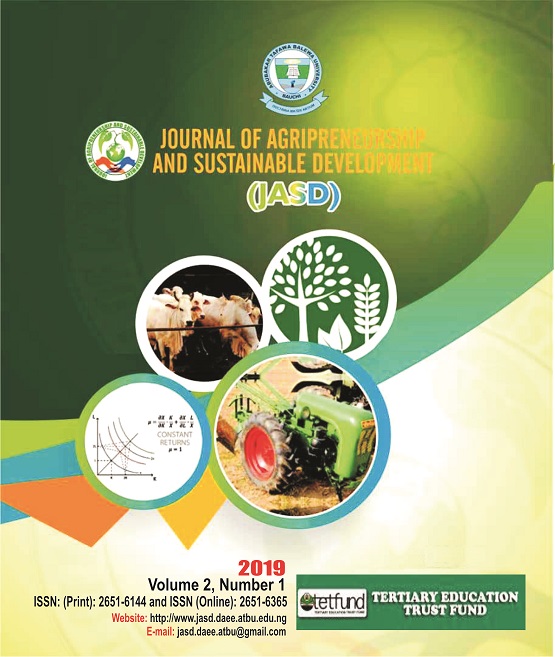SOME PHYSICAL AND CHEMICAL PROPERTIES OF SOIL AFFECTED BY THE APPLICATION OF DIFFERENT SOURCES OF LIME IN ABUJA, NIGERIA
DOI:
https://doi.org/10.59331/jasd.v2i1.66Keywords:
Abuja, Chemical Properties of Soil, Physical, Sources of LimeAbstract
A field experiment was conducted at University of Abuja Teaching and Research farm, F.C.T-Abuja, Nigeria to determine the effects of different sources of lime on soil properties. The experiment was laid out in a Randomized Complete Block Design (RCBD) in factorial fashion comprising six treatments replicated three times. The treatment includes two types of industrial lime (ultrasol - V1 and agricultural lime – V2) applied at three different levels. Data collected from the study were analyzed using Analysis of Variance (ANOVA) and means were separated with Duncan’s New Multiple Range Test (DNMRT). The result obtained showed a high significant effects of treatments on soil chemical properties. The soil chemical properties were calcium (Ca), with the application of V2L1 (1000kg/ha) giving the highest value relative to other treatments and control. Soil exchangeable magnesium showed a significant effect in the control plot (V2Lo). Percent organic carbon and percent organic matter content in the soil were highly significant in plots treated with V1L2 (ultrasol lime at 2000kg/ha). Exchangeable potassium (k) and sodium (Na) produced the highest values in plots amended with V1L1 (ultrasol lime at 1000kg/ha) though not significant. Base saturation was increased though not significant in V2L1 (agricultural lime at 1000kg/ha) treated plot. CEC (Cation Exchange Capacity) increased in the V2L0 (agricultural lime at 0kg/ha) but was not significant. Exchangeable acidity reduced greatly in V1L2 and V2L1 treated plots. Electrical conductivity in the soil and percent total nitrogen showed no significant difference but produced the highest values in plots amended with V1L1. Manganese (Mn) and copper (Cu) in the soil were influenced by treatments with the lowest values in plots treated with V2L2 (agricultural lime at 2000kg/ha) though not significant. Iron (Fe) was reduced in plot treated with V1L0 (ultrasol lime at 0kg/ha) but was not significantly different. Zinc (Zn) was completely eliminated on the application of both agricultural and ultrasol limes. Available phosphorus had no significant influence on the amended plots and control. Soil pH (in water (H2O), potassium chloride (KCl) and in calcium chloride (CaCl2) showed no significant effect on treatments and control. Based on the following results, the use of agricultural lime (V2) and ultrasol lime (V1) both at 1000kg/ha and 2000kg/ha could be recommended for improving soil properties.
Downloads

Downloads
Published
How to Cite
Issue
Section
License
Copyright (c) 2022 Journal of Agripreneurship and Sustainable Development

This work is licensed under a Creative Commons Attribution 4.0 International License.






